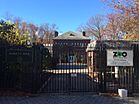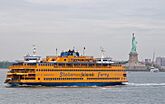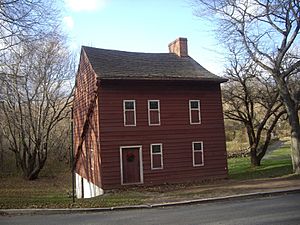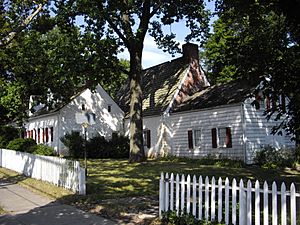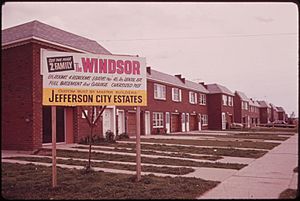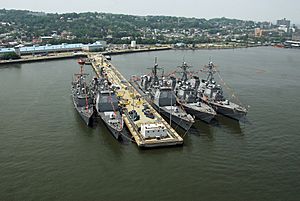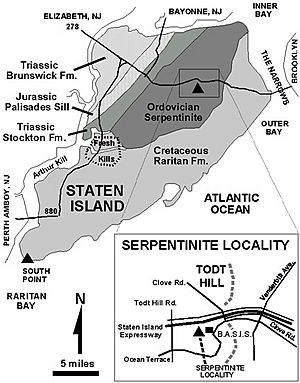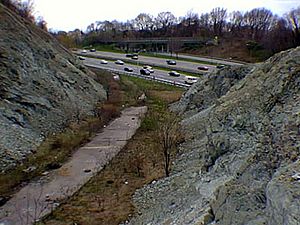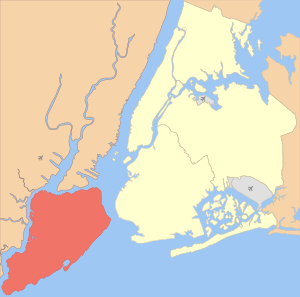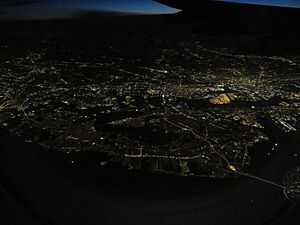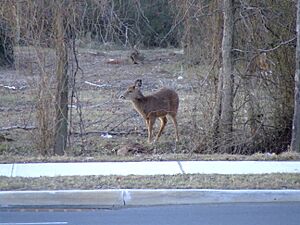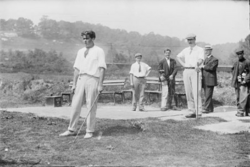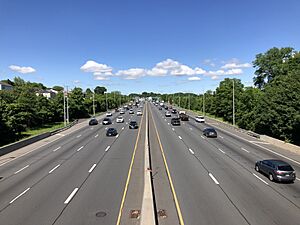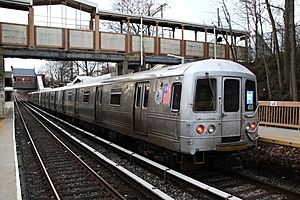Staten Island facts for kids
Quick facts for kids
Staten Island
Richmond County, New York
|
|||
|---|---|---|---|
|
College of Staten Island
|
|||
|
|||
| Country | United States | ||
| State | New York | ||
| County | Richmond (coterminous) | ||
| City | New York | ||
| Settled | 1661 | ||
| Named for |
|
||
| Government | |||
| • Type | Borough | ||
| Area | |||
| • Total | 102.5 sq mi (265 km2) | ||
| • Land | 58.5 sq mi (152 km2) | ||
| • Water | 44 sq mi (110 km2) 43% | ||
| Dimensions | |||
| • Length | 13.7 mi (22.0 km) | ||
| • Width | 8.0 mi (12.9 km) | ||
| Highest elevation | 401 ft (122 m) | ||
| Population
(2020)
|
|||
| • Total | 495,747 | ||
| • Density | 8,618.3/sq mi (3,327.5/km2) | ||
| • Demonym | Staten Islander | ||
| GDP | |||
| • Total | US$17.539 billion (2022) | ||
| Time zone | UTC−05:00 (Eastern Standard Time) | ||
| • Summer (DST) | UTC−04:00 (Eastern Daylight Time) | ||
| ZIP Code prefix |
103
|
||
| Area code | 718/347/929, 917 | ||
Staten Island is the southernmost of the five boroughs of New York City. It is also known as Richmond County. Staten Island is located at the very southern tip of New York State.
The island is separated from New Jersey by two waterways: the Arthur Kill and the Kill Van Kull. It is separated from the rest of New York City by New York Bay. In 2020, about 495,747 people lived here. This makes Staten Island the least populated borough in New York City. However, it is the third largest in land area, covering about 58.5 square miles. It is also the least crowded and most suburban borough.
Long ago, the Lenape Native Americans lived on the island. Dutch colonists settled here in the 1600s. Staten Island was one of New York State's first 12 counties. It became part of New York City in 1898. Until 1975, it was called the Borough of Richmond. People sometimes call it "the forgotten borough." This is because some residents feel the city government and media don't pay enough attention to it. It is also known as the "borough of parks." This is due to its 12,300 acres of protected parkland and over 170 parks.
The North Shore is the most city-like area. It includes neighborhoods like St. George and Stapleton. These areas have historic districts with large Victorian houses. The East Shore has the FDR Boardwalk. This boardwalk is about 2.5 miles long. The South Shore grew quickly in the 1960s and 1970s. It is now very suburban. The West Shore has the fewest people and the most factories.
You can reach Staten Island from Brooklyn using the Verrazzano-Narrows Bridge. From New Jersey, you can use the Outerbridge Crossing, Goethals Bridge, or Bayonne Bridge. Staten Island has MTA bus lines. It also has the Staten Island Railway. This train runs from the ferry terminal in St. George to Tottenville. Staten Island is the only borough not connected to the New York City Subway system. The free Staten Island Ferry connects the borough to Manhattan. It offers great views of the Statue of Liberty, Ellis Island, and Lower Manhattan.
Contents
- Staten Island's Past: A Look at History
- Staten Island's Landscape: Geology and Geography
- Who Lives on Staten Island? Demographics
- Visiting Staten Island: Tourism and Fun
- Staten Island's Culture and Arts
- Sports on Staten Island
- Learning on Staten Island: Schools and Colleges
- Getting Around Staten Island: Transportation
- Important Places: Hospitals and Jails
- Staten Island's Many Nicknames
- International Friends
- See also
Staten Island's Past: A Look at History
First People: Native Americans on Staten Island
People have lived on Staten Island for a very long time. Tools from about 14,000 years ago have been found here. These tools belong to the Clovis culture. They were first found in 1917 in the Charleston area.
Later, the island might have been empty for a while. This could be because large animals disappeared. The first permanent Native American settlements began about 5,000 years ago. They started farming around this time.
Special arrowheads called Rossville points were found here. They show a Native American culture from about 1500 to 100 BC. They are named after the Rossville area where they were first discovered.

When Europeans arrived, the Raritan band of the Lenape lived on the island. In their language, Lenape, Staten Island was called Aquehonga Manacknong. This means "as far as the place of the bad woods." It was also called Eghquhous, meaning "the bad woods." The Lenape homeland was known as Lenapehoking. The English later called the Lenape "Delaware" because they lived along the Delaware River.
The island had many Native American trails. One followed the ridge near today's Richmond Road. The Lenape moved around with the seasons. They used slash and burn farming. Shellfish like oysters were a big part of their diet. You can still see piles of oyster shells, called middens, in the Tottenville area. Some shells are over 12 inches long!
Burial Ridge in Tottenville is a Lenape burial ground. It is the largest pre-European burial ground in New York City. It is now part of Conference House Park.
European Settlers Arrive
The first European to see the island was Giovanni da Verrazzano in 1524. He sailed through The Narrows and stayed one night.
The Dutch tried to settle Staaten Eylandt (Dutch for "States Island") several times. From 1639 to 1655, their settlements were destroyed in fights with local tribes. In 1661, the first lasting Dutch settlement was built. It was called Oude Dorp (Dutch for "Old Village"). It was settled by Dutch, Walloon, and French Huguenot families. Many Huguenots were refugees from religious wars in France. At one point, almost a third of the island's residents spoke French. Today, the neighborhood of Old Town is named after this first village.
Becoming Richmond County
In 1667, the Dutch gave New Netherland to England. This happened after the Second Anglo-Dutch War. Staaten Eylandt became "Staten Island" and part of the English colony of New York.
In 1670, Native Americans gave up their claims to Staten Island to the English. To encourage more Dutch settlers, the English expanded the lots in Oude Dorp. This area became known as 'Old Town'. New lots were settled by Dutch families and called Nieuwe Dorp ("New Village"). This later became New Dorp.
In 1683, New York colony was divided into ten counties. Staten Island became Richmond County. This name came from Charles Lennox, 1st Duke of Richmond. He was a son of King Charles II.
A famous story says that Staten Island became part of New York because a captain named Christopher Billopp sailed around it in one day. This story is probably not true, but it's a fun legend!
The island was divided into four areas in 1687 and 1688. These areas later became the towns of Castleton, Northfield, Southfield, and Westfield. By 1698, the population was 727 people.
The first county seat was in New Dorp. In 1729, it moved to Richmond Town. By 1771, the island's population grew to 2,847.
Staten Island During the American Revolution
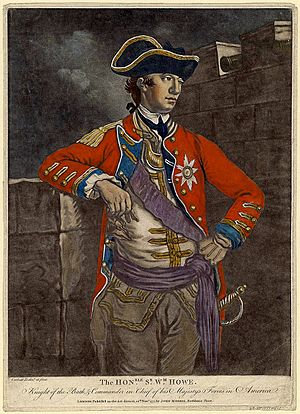
Staten Islanders mostly supported the British King during the American Revolutionary War. General George Washington even called them "our most inveterate enemies."
In March 1776, British forces under Sir William Howe came to Staten Island. They used it as a base to attack New York City. Over 140 British ships arrived that summer. About 30,000 British and Hessian soldiers gathered here. Howe's headquarters were in New Dorp.
In August 1776, the British crossed to Brooklyn. They defeated American forces at the Battle of Long Island. This gave the British control of New York City. On September 11, 1776, Lord Howe met with Benjamin Franklin, Edward Rutledge, and John Adams at the Conference House on Staten Island. The Americans refused a peace offer.
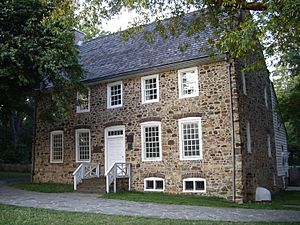
The Battle of Staten Island happened on August 22, 1777. British and American forces fought. The battle was not decisive, and the Americans eventually left.
British forces stayed on Staten Island for the rest of the war. Many buildings were destroyed for materials. The military's needs led to a lot of deforestation. The British left New York City from Staten Island on December 5, 1783. Many Loyalists (people who supported the British) left for Canada after the war.
Staten Island was occupied by the British longer than any other part of the Thirteen Colonies.
19th Century Changes
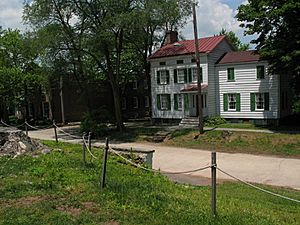
On July 4, 1827, slavery ended in New York State. This was celebrated at the Swan Hotel in West Brighton.
In the early 1800s, New Jersey and New York argued about their border. A compromise was reached. Staten Island became part of New York.
From 1800 to 1858, Staten Island had the largest quarantine hospital in the U.S. People were kept here to prevent the spread of diseases. In 1858, angry residents burned down the hospital in what was called the Staten Island Quarantine War.
In 1898, Staten Island became one of the five boroughs of the expanded City of Greater New York.
Modern Staten Island: Growth and Change
The building of the Verrazzano-Narrows Bridge and other bridges changed Staten Island a lot. It made it easier to travel from New Jersey to Brooklyn and Manhattan. This led to a lot of new homes and businesses, especially in the central and southern parts of the borough. Staten Island's population doubled from 1960 to 2000. Even so, parts of the island still had woods and marshes in 1972.
In the 1980s, some people wanted Staten Island to separate from New York City. In 1993, 65% of residents voted to secede. However, the state government blocked this plan.
The United States Navy had a base on Staten Island called Naval Station New York. It closed in 1994.
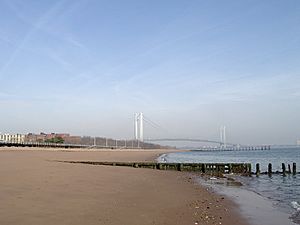
The Fresh Kills Landfill was once the world's largest man-made structure. It was a huge dump for New York City's trash. It closed in 2001. It was briefly reopened after the September 11 attacks to hold debris from Ground Zero. Now, it is being turned into Freshkills Park. This park will be almost three times the size of Central Park. It will be the largest park built in New York City in over 100 years. The park will have places for birds, roads, boardwalks, sports fields, and more.
Staten Island's Landscape: Geology and Geography
How Staten Island Was Formed: Geology Basics
Millions of years ago, huge land plates collided. This formed the Appalachian Mountains. During this process, a piece of ocean crust became part of Staten Island. This rock, called serpentinite, is the oldest on the island. It is about 430 million years old.
The Palisades Sill is a famous rock formation. It is a National Natural Landmark. You can see it in Travis. This is the same rock formation found along the Hudson River in New Jersey. It formed about 192 to 186 million years ago.
Staten Island was covered by glaciers many times. The last one, the Wisconsin glaciation, ended about 12,000 years ago. The glaciers left behind rocks and sediment. You can see these in the island's wooded areas. They left large rocks called glacial erratics and small lakes called kettle ponds.
When the ice melted, Staten Island was connected to Long Island by land. The Narrows, a waterway, had not yet formed.
Where is Staten Island? Geography Facts
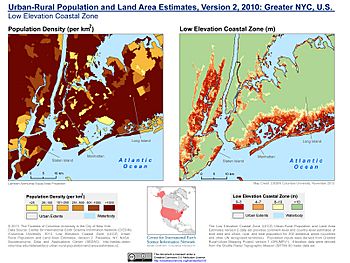
Staten Island covers about 102.5 square miles. About 58.5 square miles is land, and 44.0 square miles (43%) is water. It is the third-smallest county in New York by land area.
Even though it's a New York City borough, Staten Island is geographically close to New Jersey. It is separated from Long Island by the Narrows. It is separated from mainland New Jersey by the Arthur Kill and the Kill Van Kull. Staten Island is in the middle of New York Bight. This is a sharp bend in the coastline. The area is at risk from sea level rise. In 2012, Hurricane Sandy caused a lot of damage and loss of life here.
Staten Island also includes several small, uninhabited islands:
- The Isle of Meadows
- Prall's Island
- Shooters Island (partly in New Jersey)
- Swinburne Island
- Hoffman Island
The highest point on the island is Todt Hill. It is about 401 feet high. This is the highest point in all five boroughs of New York City. Ward's Point in Tottenville is the southernmost point in New York State.
Staten Island is the only New York City borough that does not touch another borough by land.
Amazing Wildlife on Staten Island
Staten Island has many different kinds of wildlife. You can find white-tailed deer here. Their population grew from 24 in 2008 to 2,000 in 2017. This is because hunting is banned and there are no natural predators.
Hundreds of bird species live here. These include bald eagles, turkeys, hawks, and egrets. Other animals include Atlantic horseshoe crabs, cottontail rabbits, opossums, raccoons, and various snakes and turtles. In 2014, a new frog species, the Atlantic Coast Leopard Frog, was discovered on Staten Island.
Staten Island's Beautiful Parks
Staten Island has thousands of acres of park land. This includes federal, state, and local parks. It has "greenbelt" and "blue belt" park systems. The Gateway National Recreation Area is also here. The National Park Service has firefighters who patrol these areas for wildfires.
Different groups manage the parks on Staten Island.
The U.S. National Park Service manages five sites in the Gateway National Recreation Area:
The New York State Office of Parks, Recreation and Historic Preservation manages two state parks:
The New York State Department of Environmental Conservation manages 359 acres of State Forests and wetlands.
The New York City Department of Parks and Recreation manages 156 parks. These include:
- Conference House Park
- Willowbrook Park
- Graniteville Quarry Park
- Silver Lake Park
- Clove Lakes Park
The Fresh Kills Landfill is being turned into Freshkills Park. This will be New York City's second largest public park. It will restore natural habitats.
Who Lives on Staten Island? Demographics
| Historical population | |||
|---|---|---|---|
| Census | Pop. | %± | |
| 1790 | 3,835 | — | |
| 1800 | 4,564 | 19.0% | |
| 1810 | 5,347 | 17.2% | |
| 1820 | 6,135 | 14.7% | |
| 1830 | 7,082 | 15.4% | |
| 1840 | 10,965 | 54.8% | |
| 1850 | 15,061 | 37.4% | |
| 1860 | 25,492 | 69.3% | |
| 1870 | 33,029 | 29.6% | |
| 1880 | 38,991 | 18.1% | |
| 1890 | 51,713 | 32.6% | |
| 1900 | 67,021 | 29.6% | |
| 1910 | 85,969 | 28.3% | |
| 1920 | 116,531 | 35.6% | |
| 1930 | 158,346 | 35.9% | |
| 1940 | 174,441 | 10.2% | |
| 1950 | 191,555 | 9.8% | |
| 1960 | 221,991 | 15.9% | |
| 1970 | 295,443 | 33.1% | |
| 1980 | 352,029 | 19.2% | |
| 1990 | 378,977 | 7.7% | |
| 2000 | 443,728 | 17.1% | |
| 2010 | 468,730 | 5.6% | |
| 2020 | 495,747 | 5.8% | |
| U.S. Decennial Census 1790–1960 1900–1990 1990–2000 2010 2020 |
|||
|
New York City's five boroughs
|
||||||
|---|---|---|---|---|---|---|
| Jurisdiction | Population | Land area | Density | |||
| Borough | County | Estimate (2015) |
square miles |
square km |
persons / sq. mi |
persons / sq. km |
|
|
|
1,644,518 | 22.83 | 59.1 | 72,033 | 27,826 |
|
|
|
1,455,444 | 42 | 110 | 34,653 | 13,231 |
|
|
|
2,636,735 | 71 | 180 | 37,137 | 14,649 |
|
|
|
2,339,150 | 109 | 280 | 21,460 | 8,354 |
|
|
|
474,558 | 58.5 | 152 | 8,112 | 3,132 |
|
|
8,550,405 | 303.33 | 781.1 | 28,188 | 10,947 | |
|
|
19,795,791 | 47,214 | 122,284 | 416.4 | 159 | |
|
|
||||||
| Race | 2020 | 2010 | 1990 | 1970 | 1950 |
|---|---|---|---|---|---|
| White | 59.6% | 72.9% | 85% | 94% | 97.1% |
| —Non-Hispanic | 56.1% | 64.0% | 80% | n/a | n/a |
| Black or African American | 10.5% | 10.6% | 8.1% | 5.3% | 2.8% |
| Hispanic or Latino (of any race) | 19.6% | 17.3% | 8% | n/a | n/a |
| Asian | 12.0% | 7.5% | 4.5% | 0.4% | 0.1% |
| Two or more races | 7.8% | 2.6% | n/a | n/a | n/a |
In 2018, about 22.2% of residents were born in other countries. Staten Island has the lowest poverty rate among the five boroughs, at 11.9%. The average income per person was $33,922. The average household income was $76,244.
Staten Island has the highest rate of home ownership in New York City, at 69.5%. The average home value was $460,200. There are about 166,150 households, with 2.82 people per household.
In 2010, 468,730 people lived on Staten Island. This was a 5.6% increase since 2000. Staten Island is the only New York City borough where most people are non-Hispanic White. In 2010, 64.0% of the population was non-Hispanic White.
Many different cultures live on Staten Island. It has the highest percentage of Italian Americans of any county in the U.S. There is a large Jewish community, especially in the Willowbrook area. A growing Russian community is found in Rossville and South Beach. There is also a big Polish community in South Beach and Midland Beach.
Staten Island also has a large Sri Lankan community. It is concentrated on Victory Boulevard. The Little Sri Lanka area in Tompkinsville is one of the biggest Sri Lankan communities outside of Sri Lanka. The island is home to more Liberians than anywhere outside Liberia. It has even had three Liberian leaders live there.
Most of the borough's African American and Hispanic residents live north of the Staten Island Expressway. Most people on Staten Island are Roman Catholic.
Languages Spoken on Staten Island
In 2010, most Staten Island residents (70.39%) spoke only English at home. Other languages spoken include Spanish (10.02%), Russian (3.14%), Italian (3.11%), and Chinese (2.39%). In total, about 29.61% of Staten Island's population spoke a language other than English at home.
Visiting Staten Island: Tourism and Fun
In 2009, Borough President James Molinaro started a program to bring more tourists to Staten Island. This included a new website and videos shown at ferry terminals.
Empire Outlets New York City is a large shopping center. It is about 350,000 square feet. It is located in the St. George neighborhood. It has 100 designer outlet stores. This is the first outlet mall in New York City. It is right next to the St. George Terminal, where ferries, trains, and buses meet.
Staten Island's Arts District is on the North Shore. It has many places for music and art. The Snug Harbor Cultural Center and Botanic Gardens is a great spot. It has The Staten Island Museum, The Staten Island Children's Museum, and The Chinese Scholar's Garden. The St. George Theater is a historic place. It hosts many music artists. ArtSpace shows art by local artists. Maker Park Radio is the island's only community radio station. The Alice Austen House is a historic photography gallery with great views of Manhattan.
Staten Island is called the "borough of parks" for a good reason. It has many parks like Clove Lakes, Silver Lake, Greenbelt, and High Rock. Paulo's Peak offers amazing views of the borough.
Staten Island's Culture and Arts
Supporting Local Arts

Many artists and musicians are moving to Staten Island's North Shore. They can find affordable places to live and work here. Filmmakers also add to the art scene. Staten Island Arts helps local artists and groups. The Staten Island Film Festival (SIFF) started in 2006. It shows independent and international films.
Popular Attractions
Historic Richmond Town is a living history village and museum. You can learn about American history here. It has about 15 restored buildings. These include homes, shops, and a museum.
The Staten Island Zoo is also on the island. It opened in 1936. It was the first zoo in the U.S. focused on education. In the 1960s, it had the world's largest collection of rattlesnakes.
Museums to Explore
You can visit many museums on Staten Island. These include:
- Snug Harbor Cultural Center
- Alice Austen House Museum
- Conference House
- Garibaldi–Meucci Museum
- Historic Richmond Town
- Jacques Marchais Museum of Tibetan Art
- Noble Maritime Collection
- Sandy Ground Historical Museum
- Staten Island Children's Museum
- Staten Island Museum
- Staten Island Botanical Garden, which has the New York Chinese Scholar's Garden
The National Lighthouse Museum opened an education center in St. George in 2015. The Staten Island Museum opened a new branch in Snug Harbor in 2015.
The Seguine Mansion is a beautiful 19th-century house. It is on Lemon Creek. It is a historic landmark and has peacocks and a horse riding center.
Local News
Staten Island's local newspaper is The Staten Island Advance. It also has a website called silive.com.
Staten Island in Movies and TV
Many movies and TV shows have been filmed on Staten Island. Some famous ones include:
- The Godfather
- Goodfellas
- School of Rock
- The King of Staten Island
- What We Do in the Shadows (TV series) (a comedy horror series about vampires living on Staten Island)
The truTV show Impractical Jokers features four friends from Staten Island. They often film in the borough. February's first Monday is "Impractical Jokers Day" on Staten Island!
Music Scene
Staten Island has a lively music scene. The North Shore has many venues. The hip-hop group Wu-Tang Clan is from Staten Island. They gave the island the nickname "Shaolin Land."
Theater Venues
The St. George Theatre is a cultural arts center. It hosts concerts, comedy shows, and Broadway tours. Famous artists like the B-52's and Tony Bennett have performed there.
The Ritz Theater in Port Richmond was once a movie and vaudeville theater. It hosted many rock and roll stars in the 1970s.
Sports on Staten Island
Baseball Fun
The Staten Island Yankees played in the New York–Penn League until 2020. They were a minor league team for the New York Yankees. Now, Staten Island is home to the Staten Island FerryHawks. They play in the Atlantic League at Staten Island University Hospital ballpark.
Staten Island's Mid-Island Little League won the 1964 Little League World Series.
Basketball Stars
Many great basketball players have come from Staten Island. Kyle McAlarney is Staten Island's all-time high school boys' scoring leader.
Bowling Champions
Staten Island has produced national and world-class bowlers. These include Mark Roth and Johnny Petraglia.
Boxing Heroes
The Daily News Golden Gloves Tournament started in 1927. Many Staten Islanders have won championships in this boxing event.
College Sports
Wagner College's teams are called the Seahawks. They play in NCAA Division I. The College of Staten Island's teams are the Dolphins. They play in NCAA Division II.
Cricket History
The Staten Island Cricket Club started in 1872. It is the oldest continuously running cricket club in the United States.
Football Legends
Staten Island once had an NFL team called the Stapletons. They played from 1929 to 1932. Hall of Famer Ken Strong played for them.
Many NFL players and coaches were born on Staten Island.
Golf Courses and Champions
Staten Island has four golf courses. Three are public: La Tourette, Silver Lake, and South Shore. Richmond County Country Club is the only private golf club in New York City.
Many golf champions have ties to Staten Island. Bill Britton and Jim Albus learned to play here. Carolyn Cudone, who grew up on Staten Island, won five U.S. Senior Women's Amateur championships in a row.
Ice Hockey Players
Several NHL players were born on Staten Island. These include Nick Fotiu and Kevin Labanc.
Motor Sports
From 1953 to 1972, stock car races were held weekly at Weissglass Stadium. There was a plan to build a large NASCAR racetrack on the island, but it was canceled in 2006.
Olympic Athletes from Staten Island
Many athletes from Staten Island have competed in the Olympic Games. Some have even won medals!
- John Henry Lake (1900: Cycling, Bronze medal)
- Abel Kiviat (1912: Athletics – 1500 Meters, Silver medal)
- Frankie Genaro (1920: Boxing – Flyweight, Gold medal)
- Marcus Browne (2012: Boxing – Light Heavyweight)
Running and Swimming
The New York City Marathon starts on Staten Island every year.
The Ocean Breeze Track and Field Athletic Complex is a modern indoor track facility. It is recognized as an international facility.
In 1961, a lifeguard was the first person to swim around Staten Island. In 2023, Leslie Hamilton became the first woman to do it. She swam 37 miles in 14.5 hours!
Tennis History
Tennis is believed to have started in the United States on Staten Island. The first American National championship was played here in 1880. Mary Ewing Outerbridge brought tennis to Staten Island.
Learning on Staten Island: Schools and Colleges
Public Schools for All Ages
The New York City Department of Education manages public schools on Staten Island. This is the largest public school system in the U.S.
Public middle schools include Intermediate Schools 2, 7, 24, 27, 30, 34, 49, 51, 61, 72, and 75. The Petrides School goes from kindergarten through high school.
Public high schools include:
- College of Staten Island High School for International Studies
- Curtis High School
- Gaynor McCown Expeditionary Learning School
- New Dorp High School
- Port Richmond High School
- Ralph R. McKee CTE High School
- Staten Island Technical High School
- Susan E. Wagner High School
- Tottenville High School
Private Schools on the Island
- Staten Island Academy is the only independent private school on the island.
- Catholic High Schools: Monsignor Farrell High School (all-boys), Moore Catholic High School (co-ed), Notre Dame Academy (all-girls), St. Joseph by the Sea High School (co-ed), St. Joseph Hill Academy (all-girls), St. Peter's Boys High School (all-boys).
- Islamic School: Miraj Islamic School (co-ed).
- Jewish Schools: Jewish Foundation School (co-ed), Mesivtha Tifereth Jerusalem, Staten Island campus (all-boys), Yeshiva Merkaz HaTorah (separate boys and girls).
Colleges and Universities
- The College of Staten Island is part of the City University of New York (CUNY). It offers associate's, bachelor's, master's, and doctoral degrees.
- Wagner College is a private liberal arts college. It has about 2,000 undergraduate students.
- St. John's University had a campus on Grymes Hill from 1971 to 2024.
Getting Around Staten Island: Transportation
Bridges Connecting Staten Island
Staten Island connects to New Jersey with three bridges for cars and one for trains.
- The Outerbridge Crossing goes to Perth Amboy, New Jersey.
- The Bayonne Bridge goes to Bayonne, New Jersey.
- The Goethals Bridge connects to Elizabeth, New Jersey.
- The Arthur Kill Vertical Lift Bridge carries freight trains to New Jersey.
The Verrazzano-Narrows Bridge connects Staten Island to Brooklyn. You can walk on the Bayonne and Goethals Bridges.
For a time, Staten Island had the longest vertical lift, steel arch, and suspension bridges in the world. The Arthur Kill Bridge is still the longest vertical lift bridge.
Roads and Driving
In 2015, 82% of Staten Island homes owned a car. This is the highest rate in any New York City borough. Unlike other boroughs, Staten Island does not have a large grid system for its roads. Hylan Boulevard is the longest street in New York City.
Public Transportation Options
Public transportation on Staten Island includes:
- The Staten Island Ferry
- NYC Ferry (St. George route)
- The Staten Island Railway
- MTA Regional Bus Operations (local and express buses)
Staten Island Ferry: A Free Ride

The Staten Island Ferry is the only direct way to get from Staten Island to Manhattan. The trip takes about 25 minutes. The ferry has been free since 1997. It carries over 60,000 passengers every day. It runs 24/7, every 15 to 30 minutes.
An NYC Ferry route also connects St. George Terminal to Manhattan's West Side. This route started in August 2021 and charges a fare.
Trains on the Island
The Staten Island Railway is the only passenger train on the island. It runs 24/7 from the northeast to the southwest tip. It opened in 1860.
Staten Island is the only borough not connected to the New York City Subway. A subway tunnel started being built in 1923 but was stopped two years later. Parts of it are still under Owl's Head Park in Brooklyn.
There are proposals to bring back passenger train service along the north shore. There is also a plan for a West Shore Light Rail.
Bus Services
MTA Regional Bus Operations provides local and express bus service. There are over 30 local bus lines. Most of them go to the St. George Terminal. Some lines go to Brooklyn. Express buses go to Lower Manhattan, Union Square, and Midtown Manhattan. The express bus fare is $6.75.
Freight Trains
Conrail Shared Assets Operations runs freight trains on Staten Island. They use the Travis Branch line. This line connects to the national rail system. It uses the Arthur Kill Rail Bridge to New Jersey.
Important Places: Hospitals and Jails
Hospitals on Staten Island
Staten Island is the only borough without a hospital run by New York City. The Richmond University Medical Center and the Staten Island University Hospital are privately operated.
Jails and Detention Centers
Staten Island is the only borough without a major New York City Department of Correction detention center. The Department of Corrections only has small holding jails at the three court buildings. These are for inmates attending court.
The Staten Island county sheriff used to run a jail system until 1942. The Arthur Kill Correctional Facility was on Staten Island from 1976 to 2011.
Staten Island's Many Nicknames
Staten Island has several nicknames. One is "The Forgotten Borough." This name was used almost 100 years ago. It became more popular during the 1990s when people wanted Staten Island to separate from New York City. It was also used after Hurricane Sandy.
Another nickname is "the borough of parks." This is because of its many protected parklands and green spaces. The island has 12,300 acres of parkland and over 170 parks.
The hip-hop group Wu-Tang Clan calls Staten Island "Shaolin Land" or simply "Shaolin." Some people also call the island "The Rock."
International Friends
Staten Island is twinned with Ulcinj, Montenegro.
See also
 In Spanish: Staten Island para niños
In Spanish: Staten Island para niños



